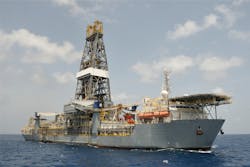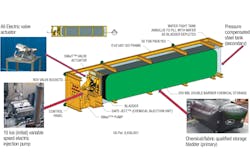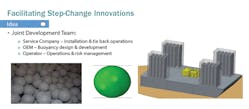According to several recent headline articles, cost-effective subsea tiebacks will drive deepwater development for the near to intermediate future. Operators have spent billions of dollars developing world-class hubs in deepwater over the last couple decades. As wells initially supporting those facilities start to fall off peak production, operators are looking for new production opportunities via longer distance tiebacks.
David O’Conner, BP head of global projects, said, "If we can keep every one of those facilities full … that’s our strategy … fast-paced tiebacks fit in really nice."1 Starlee Sykes, now regional president, Gulf of Mexico and Canada at BP stated, "… developing subsea tiebacks … We are going to fill those deepwater hubs with tiebacks." Wood Mackenzie’s latest subsea tree awards forecast indicates about a 250-percent increase from 2016 levels over the next five years. Subsea chemical storage and injection systems that can enable ultra-long tiebacks will help meet this industry need. These subsea systems will bring lower costs and increased operational flexibility as production characteristics change over the life of the field.
The incumbent technology that facilitates subsea tiebacks is the umbilical. This complex, custom-designed piece of equipment provides the well and subsea infrastructure with power and control — hydraulics usually and production chemicals. As tieback distances and well pressures increase, limits of reach and performance are stretched, costing dollars and system performance.
Some of the most challenging and costly aspects are the embedded tubes that carry the chemicals and hydraulic fluids. Thinners are sometimes used to help reduce the viscosity of production chemicals and allow them to be pumped longer distances through the small-diameter umbilical tubes. As wells produce, production content and profiles may change with time and require different chemical treatments. With accurate foresight, these potential needs may be addressed in advance by adding additional tubes in the original umbilical bundle — which of course drives up costs. Sometimes operators are forced to mix a cocktail of chemicals to match the number of tubes available. Whether it is the cocktail approach or contaminants in the chemicals (mixing chemicals from different manufacturers may also contribute) or plugging/corrosion, umbilical tube management can be a costly issue, especially during a well’s tail production period when costly umbilical replacement may not be an economical alternative. At this point, not only is the operator faced with a costly well plug and abandon, but also potential umbilical recovery.
Figure 1. 200-bbl subsea chemical storage and injection unit
Subsea storage of production chemicals (and hydraulic fluid for non-electrically controlled wells) along with local injection of the same will eliminate the need for tubes in the umbilical. Case studies have indicated removal of the tubes from umbilicals — leaving only fiber for control and copper wire for power — can reduce umbilical costs by up to 80 percent. Traditional topside chemical storage, pumping and control have space and weight requirements. When placed subsea, platform costs can be reduced. Additionally, typical production chemicals are toxic and require stringent personal protective equipment when operating personnel come in proximity for refill, inspection, maintenance or repair.
Production chemicals generally are utilized in one of two ways: continuously injected in lower volume ranges or for mitigation of corrosion, asphaltenes, scale, etc. Chemicals such as methanol and ethylene glycol are utilized in a batch, high-rate mode for hydrate mitigation during well startup and shutdown. The equipment requirements for both types of systems are similar — they require pumps, meters, controls and storage. With the low-rate system, 200 barrels (bbl) storage may be sufficient for a six- to 18-month single-well supply. For a multiwell tieback, high-rate methanol system, storage requirements for the same operational window may be in the couple thousand-barrel range. The size (and weight) of the storage system will have a significant impact on its installation and recovery.
Figure 1 depicts a 200-bbl storage unit with accompanying pumps and controllers. The unit is ISO container-sized (8’x 8’x40’) and is over road truckable (~15 tons dry). Weighing in at approximately 50 tons filled with chemical, the unit may easily be deployed and recovered in up to 10,000 feet seawater (fsw) with a multiservice vessel equipped with a remotely operated vehicle (ROV) unit and a 100-ton, motion-compensated crane. Its pressure-compensated, dual-barrier design facilitates a "design and engineer one, build many" philosophy. The concept of operations is that identical modules are swapped out after the chemical supply in the operating unit is consumed versus a surface vessel to subsea unit (via a riser) refill. Because the unit comes back to the beach for refill, it can be inspected and maintained while being refilled, eliminating the need for a subsea operations/construction campaign. Because the entire unit is recovered, expensive wet-connects, additional pipe, valves, manifolds and controls can be eliminated. Additionally, since the unit returns to shore every year or so, design life can be significantly shortened from a traditionally specified 20 to 30 years to a more manageable 10-year design and 5-year operational life for the equipment/components, saving even more costs and removing complexity.
Figure 2. The seafloor delivery and recovery system has 3,000-bbl chemical storage or 600-ton subsea facility capacity.
Depending on field needs, several 200-bbl units could be manifolded together to meet chemical storage requirements. From an operational perspective, diminishing returns may layer in with the deployment of more than a handful of 200-bbl units when compared to a new alternative that utilizes the same design philosophy, injection and control equipment. The subsea transport vessel shown in Figure 2 is designed to store 3,000 bbl of production chemicals (like methanol). It features an American Bureau of Shipping hazardous cargo (double-hull) design and fixed buoyancy in each of the four corner columns. The vessel is designed with a slightly positive overall buoyancy and can be deployed and recovered with two anchor-handling vessels with an accompanying ROV for subsea hookup.
The same subsea transport vessel could also be utilized to deploy and at a later date recover various subsea production equipment packages such as pumps, compressors, motor switchgear, water treatment equipment and more in up to 10,000 fsw. The equipment packages can be installed on the vessel and hooked up to perform system integration tests (SIT) quayside to minimize offshore time and costs.
The latest version of the subsea transport vessel is being designed with adjustable buoyancy to provide even more operational flexibility, increased safety and lower costs. For example, a subsea system that initially weighs ‘x’ tons may be installed, and later on occasion for recovery may be heavier (120 percent of ‘x’) because of marine growth, sand in separators, etc.
Figure 3. An intermediate product in an existing proven manufacturing process will be utilized for adjustable buoyancy.
The utilization of adjustable buoyancy can account for this extra weight at the required time. Additionally, the buoyancy material used for vessel installation and recovery can be taken away and utilized on other projects while the vessel is on-bottom, reducing the overall effective capital costs. The buoyancy material to be utilized is an intermediate product in an existing manufacturing process that has been in use for decades with superior performance.
Subsea chemical storage and injection use cases for large and small storage systems show they are amenable to a service model in which operator needs are met with a service company that provides an operator with a fully bundled suite of services or chemicals by the barrel — similar to current onshore models.
Subsea chemical storage and injection use cases for large and small storage systems show they are amenable to a service model in which operator needs are met with a service company that provides an operator with a fully bundled suite of services or chemicals by the barrel — similar to current onshore models. A single service provider provides the storage, pump and control unit. The operator’s preference of chemical at point of injection subsea is negotiated monthly or by the chemical barrel cost. The logistics under the current practice — getting chemical to the dock, loading it onto supply vessels, transporting it to the operator’s platform, pumping/lifting the chemical to the platform deck, storing the chemical on deck, maintaining and operating the topside chemical units, buying the umbilical with the associated capital and operating costs — all go away for the operator. By utilizing subsea storage and inject units, the bundling service company provides the operator with only what it needs for as long as the need exists for a single, one-line operational expense.
The systems described previously are currently being built and qualified in Houston, Texas, with regulatory input and review.
References
1. Houston Business Journal, 2017-12-07.
Art Schroeder co-founded Safe Marine Transfer LLC (SMT) in 2013 and founded Energy Valley Inc. in 2001. Prior to Energy Valley, he spent 25 years in upstream operations, engineering, construction, strategy development and crisis management with Amoco and then BP. Schroeder has served on numerous professional, corporate and civic boards and has published more than 80 technical papers. He is the recipient of numerous awards including the Offshore Technology Conference’s (OTC) prestigious Special Citation, the Society of Professional Engineers’ (SPE) Management and Information Award and he has been granted patents on his innovations. Schroeder graduated from Georgia Tech with a Bachelor of Science and a Master of Science in chemical engineering with a minor in environmental engineering, and from the University of Houston with an MBA, major in finance and international business. He also attended Emory University under a National Science Foundation grant and completed several postgraduate certificate programs.
Collin Gaskill recently joined Trelleborg Offshore to advance in-house engineering analysis and simulation capabilities in the Houston office. His background is finite element analysis and consulting engineering for drilling riser systems and operations. Gaskill understands environmental loading on subsea equipment, which he applies to the optimization and design of current and new equipment developments. Gaskill has been heavily involved in numerous equipment development projects ranging from drilling riser vortex induced vibration suppression to downhole annulus pressure buildup mitigation. In addition to his specialty of deepwater drilling systems, he looks after a majority of the new subsea equipment and application projects in the Houston office.








